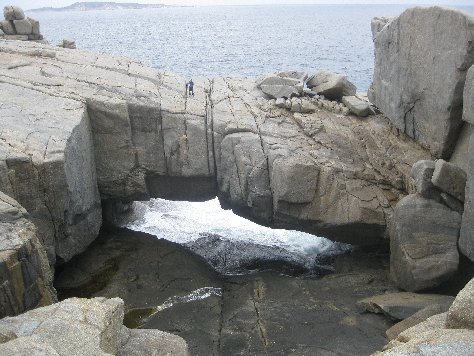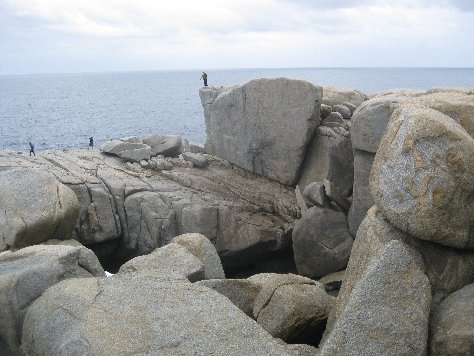9
th March, 2012
Time to move west along the south coast of
WA.
We check out a couple of camping grounds in the National Parks and find a nice quiet camp spot at Stokes Inlet where we decide to chill out for a couple of days.
The inlet is blocked by a sandbar to the open sea but every now and then the backed up water breaks through.
 |
| Stokes Inlet |
The water in the lake is very high and expectations are that the break through will happen by the end of the year. Our camp site is protected from the wind which is whipping up waves on the lake and making lots of froth.
 |
| The frothy shoreline of Stokes Inlet |
After a peaceful couple of days we continue further west checking out different spots along the coast.
We are now travelling through miles and miles of wheat fields. We still see the occasional cattle and sheep farm but wheat is obviously the major form of farming.
Unfortunately … along with the crops come pesky little critters.
We are bombarded with grasshoppers.
Nice plump ones that splatter all over the front of Mitzi and the Van as we drive along.
When we pull up at our next fuel stop we make a valiant attempt to try and get rid of some of the dead bodies.
We manage to get the windscreen and grill reasonably clear but it is impossible to get into the front of the radiator without dismantling a few panels.
All our efforts are in vain though as the kamikaze grasshoppers continue to target us as soon as we are mobile again.
We turn off the highway towards
Bremer Bay and leave the wheat fields and grasshoppers behind.
We stop beside the lovely clear waters for a late lunch and can’t resist taking a walk on the beach and dipping our toes in the surf.
 |
| Wok is enjoying playing in the small waves at Bremer Bay |
Back on the road again we stop for the night in a rest area 100 km from
Albany.
 |
| Our campsite in the rest area |
Once again a ‘whiz bang’ buzzes around us and after going around in circles settles down beside us.
We are starting to feel like a mother hen that gathers her chickens around her to nest at night.
By 10am the next morning we are checking into
Emu Beach Holiday Park at
Albany.
Wok surveys the carnage on Mitzi’s bow and pulls off the grill panels.
The radiator is plastered with the remains of dead grasshoppers.
He cleans off the remnants of wings and bodies while a couple of magpies and peewees dart in and around him for an easy meal.
In quick time they had cleaned up all the dead grasshoppers and were waiting for the next car and caravan to arrive.
We may have to seriously investigate the possibility of installing an insect guard on Mitzi to protect the radiator.
After lunch we drive into
Albany for a look around.
We only manage to get as far as Mt Adelaide which overlooks the entrance to the bay on which
Albany is situated.
Here stands Princess Royal Fortress constructed in 1893 – not a grand fort of battlements and stone as this was the age of concealment.
Its two gun batteries were dug into the hillside and the barracks housed a small garrison to man the guns.
 |
| The barracks at Princess Royal Fortress |
From 1893 to 1956 the guns never fired a shot in anger. With the advent of the missile era the guns were silenced and the Fortress closed. The buildings that were not dismantled or destroyed now house displays and a museum. We wander through the grounds and Wok finds an anti aircraft gun to play on.
 |
| Wok takes aim at an imaginary enemy |
A walk from the parade ground takes us past the slit trenches to the fortified gun emplacements and underground magazine.
 |
| Wok looks around the underground magazine |
We spend quite a lot of time in the museum displays where there are many stories and photos of troop transports on their way to Gallipoli. The guy at the gate house tells us that they will be firing one of the 1934 field guns tomorrow and stamps our tickets to allow us to come back and see it. Laundry is the first cab off the rank in the morning and by lunchtime everything is dry and back where it belongs. We head to the fortress in the afternoon to watch the firing of the field gun. We thought this photographer taking shots of the field gun crew made a pretty good photograph himself.
 |
| OK everyone - smile for the pretty birdy |
Of course being in front of the pointy end of a canon is probably not the best place to be. We were warned to put our hands over our ears when the canon fired and Wok dutifully did as he was told. Robyn however was still trying to work out how to take a photo without using her hand or hands when the charge exploded.
 |
| BANG ............... only louder! |
Well she got the shot (slight pun here) but her ears were ringing for quite some time.
The rest of the afternoon was spent stocking up on groceries and at a car wash.
The caravan park had water restrictions so the only way we could get rid of all those sticky grasshopper remains was to give Mitzi a good soapy scrub down at a car wash.
We don’t know what was in the soap but Mitzi came out sparkly and shiny.
Now if we can only get those bothersome bugs to stay off the road.
In the morning we hop into a very clean Mitzi and head to
Torndirrup National Park.
Along the way we pass the full scale replica of the brig ‘Amity’ which transported
Albany’s first British settlers from
Sydney in 1826.
 |
| Replica of the brig 'Amity' |
It is amazing to think that boats this size sailed across the oceans with crew, passengers and provisions.
They must have been a hardy lot to endure such voyages.
Our first stop for the day is at Whale World.
No ….
it’s not like Sea World.
There aren’t any whales at whale world (not alive anyway).
Whale World is on the site of
Australia’s last operational whaling station.
Albany is
Western Australia’s oldest European settlement.
Whaling was already in full swing when the British established a settlement in 1826.
The whaling station in
Frenchman's Bay finally ceased operations in November 1978 and today the site of the Cheynes Beach Whaling Company has been transformed into a tourist attraction.
Beached on shore is the whale chaser Cheynes IV where one can roam the decks, cabins and engine room.
 |
| Whale chaser 'Cheynes IV' |
A guided tour takes us around the business end of the station. From the flensing deck where large strips of blubber were stripped from the whale
 |
| The flensing deck |
to the cutting up deck where chunks of whale were fed into the cookers below and then on to the processing factory. Three huge tanks tower over us and it was astounding to think that each tank held the oil of 100 whales. In the Giants of the Sea shed the skeleton of a sperm whale is on display.
 |
| Robyn stands framed in the mouth of a whale |
The whale chasers would hunt the sperm whales way out on the continental shelf where the whales fed on their favourite food – giant squid. The boats would then tow the mighty giants back to the whaling station and the gory task of cutting up the whale would begin. We had two people in our tour group who recalled the over powering stench and the bloody waters of the bay. Massive great white sharks circled the whaling station looking for the chance to tear off a chunk of meat and a marksman was employed to shoot the sharks if they came too close. The scene would have been horrific and its no wonder that after the station closed it took over a decade before whales were once again seen swimming in the bay. Another skeleton on display is that of a Pygmy Blue Whale.
 |
| Wok looks small beside this skeleton of a Pygmy Blue Whale |
It is massive and at 22 metres is less than half the length of a Blue Whale. You would need this shed and a whole other shed to fit one of those skeletons inside! There are lots of photos and stories to read and in no time at all half the day has gone. We have lunch overlooking the crystal clear waters of the bay.
 |
| The crystal clear water of Frenchman's Bay |
Thank goodness the horrific days of whaling here are gone.
Hopefully one day soon all whaling (for whatever purpose) will come to an end.
After lunch we continue our drive through
Torndirrup National Park.
At Salmon Holes we watch rock fishermen take foolish chances trying to catch a salmon looking for calm waters close to the beach.
 |
| Salmon Holes |
You won’t be able to see the fishermen on the rocks in this photo as they are way too small but they are standing on the rock that slides down into the water on the right hand side of the photo. Wok takes a walk down the steep path to the Blowholes. Everyone coming back was saying not to bother as the blowholes weren’t blowing, but he had to check anyway. When he got back all he said was ‘Yep – they aren’t blowing’. We drive further along the coast and come to the Gap – a cleft in the rock which channels the surf through giant walls of granite.
 |
| The Gap |
We watch the water race into the gap and send up huge sprays of water.
The rocks in this area have been proved to be linked with the composition of the rocks in
Antarctica to which they were once joined.
The
Natural Bridge really needs no explanation.
 |
| Natural Bridge |
It does make for a good photo op though and Wok does some rock hopping or rock standing.
 |
| Wok wants to get a really good look at the Natural Bridge |
On the way back to
Albany we make a detour out to the wind farm where 18 large turbines stand silhouetted against the sky.
 |
| The wind farm |
The blades are turning slowly in the wind and make quite a lot of noise.
We take a drive through town to get a photo of Dog Rock.
 |
| Dog Rock in Albany (complete with collar) |
Guess there’s no prize for wondering how it got that name.
We’ve had an interesting stopover here in
Albany but before we go back to camp we stop to pick up some fish and chips for dinner from the Squid Shack.
The fish and chips have been highly recommended by the Tourist Information guy and by Kerrie and Dave from
Mount Tamborine whom we house sat for.
We judge solely on taste and not on presentation as we believe that ‘If it tastes good – who cares what it looks like!’
That being said we thought that it definitely was above average but the fish and chips we had from a café in a small town on the east coast of
Scotland still has our No. 1 vote.
Och Aye!


































































